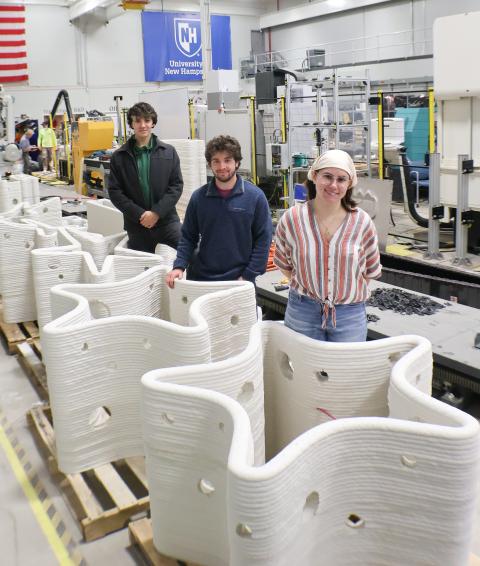
Over the 2024-2025 academic year, UNH seniors Katy Cafaro, PJ Menis, and James Grady designed an instrument that fertilizes coral reefs with aragonite. Coral uses this mineral to produce its skeleton. Feeding aragonite to coral is not a new idea. Marine biologists and at-home hobbyists have been doing this on a small scale for years, but the process stalls past indoor aquariums. The student's design takes the next step in proposing a method for fertilizing coral reefs in the ocean.
Coral is a soft, single polyp animal, usually 1 inch in diameter. It creates a self-made skeleton that serves as its anchor to the ocean floor and its ladder to the sunlight at the water's surface. The coral forms its skeleton by pulling calcium and a carbonic acid molecule from the water. It removes a hydrogen atom from the carbonic acid and combines it with calcium. This process, known as biomineralization, forms a calcium carbonate (CaCO3) or aragonite crystal. The coral then builds its skeleton crystal by crystal. As the skeleton grows outwards and upwards, other corals join, combining their efforts, slowly resulting in a reef. That reef becomes an ocean habitat and highway supporting 25% of all ocean life.
Due to the alkalization of ocean water, there is more CO2 in the ocean, which leeches the carbonate, leaving less for the coral to work with. Not only that, but biomineralization is time and energy-consuming. Coral grows approximately one inch annually, and environmental stressors, such as the decrease in carbonate, inhibit its growth.
Like an IV, the students designed a pump that distributes calcium carbonate (aragonite) by filtering water through a fertilizer cache and distributing it to the coral. The coral needs .383g of aragonite per /1 kilogram of water for the biomineralization process. The students' design will give coral a lifeline, allowing it to focus on other essential tasks.
The yearlong endeavor required the three mechanical engineering majors to explore new areas of academia. The students met with marine biologists to learn the fundamentals of coral growth, reef environments, and the effects of wave energy. Katy, James, and PJ divided and conquered. James and PJ took on an additional class on CFD (computational fluid dynamics). Using the San Juan Reef off Puerto Rico as their model and Open Foam software, James programmed simulations of the reef floor to determine the flow conditions (which change at different sea depths) and the properties of the aragonite mixture that wants to dissolve in water compared to the local water itself. The final simulations showed the radius of the device's reach in the water.
Determining the underwater wave velocities was a project in itself and required for the CFD simulation. PJ calculated the water velocities at different water depths in the San Juan reef using MATLAB. Additionally, PJ and Katy researched the pump requirements, fluid dynamics, friction, and heat losses through pipes and filters. After determining the type of pump they needed, Katy took on the final design of the filtration system and created the CAD model.
With the results of the CFD and wave simulations, the group determined that the water current wasn't enough to filter the aragonite. Most coral live near the shore, relying on peaceful and slow-moving currents traditionally ideal for delicate coral. Katey researched alternative means of power to pump the aragonite.
It's now June 2025, and the students have graduated. They designed a system to give the coral a leg up to fight the onslaught of climate change and overfishing challenges. Their advisor, Professor John Roth, says they've proved this concept is valid. While this is not a long-term solution, it has potential. Eventually, climate change will lead to the demise of our reefs. The teamwork exemplified by the three seniors is what it will take to save the reefs, coming at it from different directions. James, Katy, and PJ's apparatus can give the coral more time. The next step is to find funds and conduct further research on power sources. UNH is ready; it will take investors and interested groups to help see the project through to the next steps.
Written by Katie Ahearn
